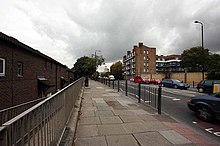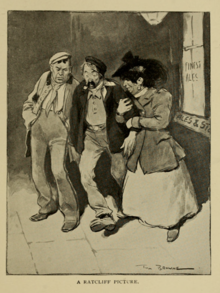The Highway, London
This articleneeds additional citations forverification.(May 2017) |
 The Highway near the junction of Garnet Street | |
| Former name(s) | Ratcliffe Highway |
|---|---|
| Length | 1.4 mi (2.3 km) |
| Location | London Borough of Tower Hamlets,United Kingdom |
| Postal code | E1,E1W |
| West end | East Smithfield |
| East end | Limehouse Link Tunnel |
| Other | |
| Known for | Ratcliff Highway murders |
The Highway,part of which was formerly known as theRatcliffe Highway,is a road in theLondon Borough of Tower Hamlets,in theEast End of London.The route dates back toRomantimes. In the 19th century it had a reputation for vice and crime and was the location of theRatcliff Highway murders.Prior to a renaming programme of 1937, different parts of the route had different names depending on what district they were in.
The name "Ratcliffe" literally means "red cliff", referring to the red sandstone cliffs which descended from the plateau on which the road was situated down to theWappingMarshes to the south.
Location
[edit]The Highway runs west–east from the eastern edge of London's financial district, theCity of London,toLimehouse.It runs parallel to and south ofCommercial Road,theDocklands Light RailwayandCable Street,and connectsEast Smithfield (the street)and theLimehouse Link tunnel.
Prior to theLondon County Councilrenaming programme of 1937, different parts of the route had different names depending on what district they were in.[1]From west to east these ran: St. George's Street East, High Street (Shadwell), Cock Hill, and Broad Street. The whole of the central area of The Highway was named afterSt. George in the East churchand the parish ofSt. George in the East.
History
[edit]The Ratcliffe (sometimes Ratcliff) Highway dates from at leastSaxonBritain, running east from theCity of London,London's historic core, along the top of aplateaunear the edge of the eponymous "red cliff" which descended onto the low-lying tidal marshes ofWappingto the south.[2]

In the late 19th centuryCharles Jamrach,a dealer in wild animals, opened Jamrach's Animal Emporium on The Highway. The store became the largest pet store in the world as seafarers moored at the Port of London sold any exotic animals they had brought with them to Jamrach, who in turn supplied zoos, menageries and private collectors. At the north entrance to the nearbyTobacco Dockstands a bronze sculpture of a boy standing in front of a tiger, commemorating an incident where a fully-grown Bengal tiger escaped from Jamrach's shop into the street and picked up and carried off a small boy, who had approached and tried to pet the animal having never seen such a big cat before. The boy escaped unhurt after Jamrach gave chase and prised open the animal's jaw with his bare hands. The tale was the inspiration for the 2011 novelJamrach's Menagerieby British authorCarol Birch.[4]

ARoman bathhouse was excavated in 2004 by the junction of The Highway and Wapping Lane. The discovery of women's jewellery along with soldiers' possessions suggested that this location outside of the Roman walls allowed less restricted use of the baths than those in the City itself. The remains of the baths and under-floor heating system were re-buried under the car-park of a development of new apartments.[6]
Song
[edit]There are two notable folk songs calledRatcliffe Highway;one is a traditional folk song (Roud598;Ballad IndexDoe114;Wiltshire785]. The other,Roud493, also calledThe Deserterand famously recorded bySandy DennyandFairport Convention,concerns a young man who is pressed-ganged into the navy on the Highway.
Landmarks
[edit]Listed from west to east:
- St Katharine Docks
- Wellclose Square
- St. Paul's primary school
- Ensign Club – a localyouth club
- Telford's Yard – a converted Victorian wool warehouse
- The Caxtonpub– displays newspaper history on the walls
- Location of theRatcliff Highway murders
- Mary Sambrook school
- The Travellers Rest – evangelical church
- The Old Rose pub
- Tobacco Dock– former warehouses for imported tobacco, converted to retail outlets
- St George in the East– a white stone church that has dominated the area since 1729
- St. George's recreation ground
- St. George's swimming pool
- Green GablesMontessorischool
- St. Paul's Church, Shadwell– the church of sea captains
- Shadwell Basin– old dock now used for watersports and fishing.
- Glamis Adventure Playground – an example of the London style of adventure playgrounds created in the early 1970s
- King Edward Memorial Park
- Limehouse Link tunnel
Transport
[edit]Road
[edit]The Highway is a major arterial route into and out of theCity of Londonand can become heavily congested during rush hour. There are two lanes in each direction throughout its length. It lies outside of theLondon congestion chargezone (CCZ).
Bus
[edit]There are few bus stops on The Highway, butLondon Busesroutes 100 and D3 pass along short lengths of it. Route 100 connects toShadwell,Liverpool Street,St. Paul'sandElephant and Castle,while D3 connects to theIsle of Dogs,Limehouse,ShadwellandBethnal Green.
Rail
[edit]The following stations are located on or near The Highway, all inTransport for London's fare zone 2:
- Wapping(East London Line,now part ofLondon Overground)
- Tower Hill(CircleandDistrict lines)
- Shadwell DLR(also aLondon OvergroundStation
- Limehouse DLR(also aNational Railstation)
People
[edit]Some names associated with the area include:
- Arthur Morrison(1863–1945), author, wrote about Ratcliff Highway in his novelThe Hole in the Wall(1902)
- SirWilliam Henry Perkin(1838–1907), chemist who discoveredmauveine,who was baptised atSt. Paul's Church, Shadwell
- Oscar Wilde(1854–1900), visited the opium dens near Dellow Street
- SirArthur Conan Doyle(1859–1930), visited the opium dens as research for his detective characterSherlock Holmes
- Charles Jamrach(1815–1891), importer and dealer of wild and exotic animals who owned a shop on the street

- CaptainJames Cook(1728–1779), explorer and cartographer, who lived in the area from 1763 to 1765 and baptised some of his children at St. Paul's Church, Shadwell. Ablue plaquecommemorates him at No. 326, The Highway. (A slate plaque also marks another of his homes at No. 88,Mile End Road.)
- Jane Randolph(1720–1776), mother ofThomas Jefferson,was baptised at St. Paul's Church, Shadwell
- John Wesley(1703–1791), the famous cleric, who preached at St. Paul's Church, Shadwell
- Nicholas Hawksmoor(1661–1736), the architect who designed the church of St. George in the East
The following people inspired some local street names:
- Nathaniel HeckfordandSarah Maud Heckford– a young doctor and his wife who founded the first children's hospital in East London
- Daniel Solander– a Swedish botanist who travelled withJames Cookexploring the Pacific islands
- Emanuel Swedenborg– a Swedish scientist, philosopher and mystic in the Georgian era
Neighbouring streets
[edit]West of The Highway:
North of The Highway, from west to east:
- Cable Street– runs parallel to The Highway
- Dock Street
- Ensign Street – formerly Wells Street (1862)
- Hard's Place – a path between Wellclose Square and the south end of Ensign Street
- Grace's Alley – formerly Gracie's Alley, a path between Wellclose Square and the north end of Ensign Street, and home toWilton's Music Hall
- Wellclose Square
- SwedenborgGardens
- Betts Street – formerly connected Cable Street to The Highway
- Crowder Street – formerly Denmark Street
- Cannon Street Road
- Dellow Street
- SolanderGardens
- King David Lane
- Juniper Street – formerly Juniper Row
- Tarbert Walk
- Redcastle Close – formerly Carriage Way
- Glamis Road
- Glamis Place
- Brodlove Lane – formerly Love Lane
- Elf Row – formerly Elm Row
- Glasshouse Fields – formerly Glasshouse Street
- Schoolhouse Lane
- HeckfordStreet – formerly Burlington Place, a trades wholesaler park
- Ratcliffe Orchard – formerly The Orchard
East of The Highway:
- Butcher Row – formerly White Horse Street
- Narrow Street
- Limehouse Link tunnel
South of The Highway, from west to east:
- Vaughan Way
- Telford's Yard
- Artichoke Hill – the escape route for the Ratcliff Highway murderers
- Chigwell Hill
- Pennington Street
- Wapping Lane – formerly Old Gravel Lane
- Sovereign Close
- Princes Court
- West Gardens
- Rum Close
- Garnet Street – formerly New Gravel Lane
- Newlands Quay – formerly Elbow Lane
- Maynards Quay
- Glamis Road
- Pear Tree Lane – formerly Fox's Lane, now named after The Pear Tree, the inn where the secondRatcliff Highway murderstook place
- Shadwell Basin
- Jardine Road
- Rialto Avenue
References
[edit]Citations
- ^Waeppa's People, A History of Wapping, Madge Darby, 1988
- ^Weinreb et al. 2008,p. 682.
- ^Frank T. Bullen, "With Christ in Sailor Town", (Hodder & Stoughton: London), 1901, p.35.
- ^"BBC - Tiger snatch tale inspires Docklands novel".
- ^From Machray, Robert,The Night Side of London,1902; illustration by Tom Browne.
- ^"Roman Bath House, Shadwell, Non Civil Parish - 1456951".Historic England. 5 June 2019.Retrieved18 September2023.
Sources
- Weinreb, Ben;Hibbert, Christopher;Keay, John;Keay, Julia (2008).The London Encyclopaedia(3rd ed.). Pan Macmillan.ISBN978-1-405-04924-5.
